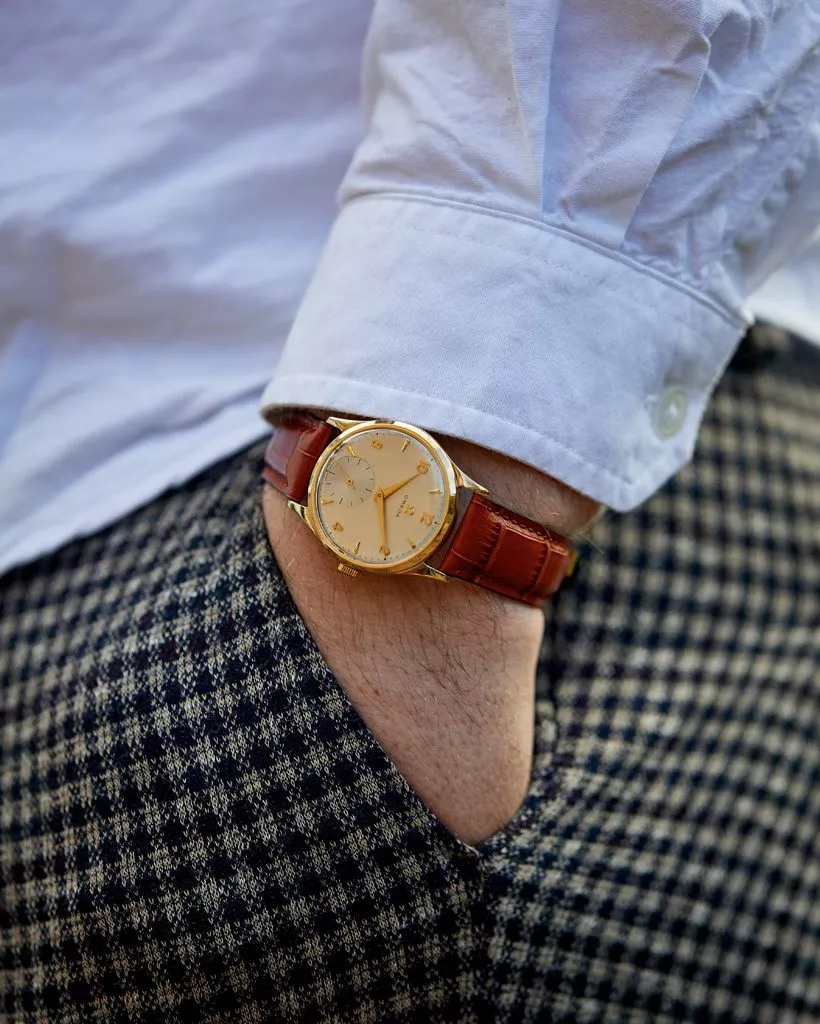By Alan Wood
Vintage Omega watches have never been so collectable. Highly esteemed for their high standards of in-house manufacture, accuracy and reliability, there is a lot to admire about Omega. But which models make the vintage collectors cut? And what makes them so special? Discover the best vintage Omega watches worth collecting according to our experts.

Alan Wood is a trusted vintage watch dealer with over 35 years of private collecting experience. After founding Vintage Gold Watches in 2011, his deep knowledge and infectious passion for mechanical timepieces earned him a highly respected reputation in the industry. Vintage Gold Watches has become a renowned dealer thanks to Alan’s expertise and skilled team of restorers. Alan’s love for vintage watches started as a young Mechanical Entrepreneur and grew into an obsession. He believes the finest watches were made in the 1950s, 60s, and 70s, and is thrilled to share them with others.
History of Omega
Omega is one of the most iconic and respected watch brands in the world. Few other watchmakers can stand aside Omega in terms of horological history, stand-out design and sheer quality. Its celebrity status has been bolstered over the years by its long list of impressive achievements boosting it to superstar status.
One of Omega’s best-known accomplishments includes being the first watch worn in space to land on the moon. Omega became the official supplier to NASA in the early 60s. The Speedmaster ref. CK 2998 was the first watch to reach space when astronaut Walter Schirra wore the Speedmaster during the ‘Sigma 7’ mission in 1962.
Later on, in 1969, Buzz Aldrin and Neil Armstrong famously wore the same model in the Apollo 11 moon landing. This alone engraved Omega in the minds of a generation.
Its commitment to accuracy has naturally lent itself to sporting timekeeping. Most famously, it has been the official timekeeper at the Olympic Games since 1932 and a long-standing sponsor of the golf European Masters. Its enthusiasm for golf has inspired many of Omega’s finest wristwatches, including the models in the Seamaster Aqua Terra “Golf” collection.
Unsurprisingly, this acclaimed heritage and luxury has drawn the attention of the rich and famous. Worn by President JFK, Elvis Presley, Cindy Crawford, George Clooney, and Daniel Craig, and the choice of James Bond since the mid-90s. Its fame, credibility and collectability are indisputable.
Omega Seamaster
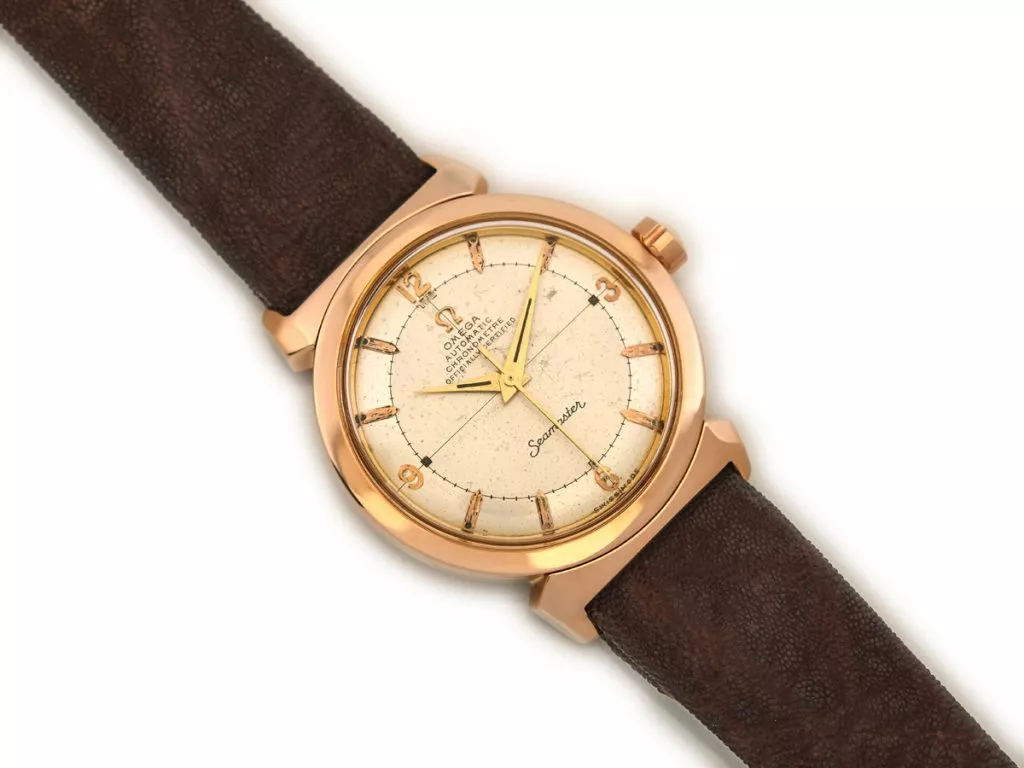
Famously the watch of choice for Prince William and James Bond, the Seamaster, along with the Speedmaster, is Omega’s best-known and most loved model of all time.
The Omega Seamaster was first released in 1948 and continues to be a cornerstone in the Omega collection. The Seamaster was initially introduced as a ‘sporty’ dress watch and due to its popularity and success, divers versions were later introduced in the 1970s. The Seamaster Ploprof, for example, was used by the world-renowned scuba diving pioneer Jacques Cousteau in a series of experimental dives to depths of around 500 metres.
An example of a collectable model from the 1960s is this Cal.562 9-carat 1966. The style on this piece is classic 1960s Omega, with an ivory cream dial with applied yellow gold ‘baton’ hour indices, matched with original classic ‘dauphine’ hands.
The Omega Cal.562 movement was the first Omega movement to include a quickset date function. This means instead of continuously rotating the hands forward to set the required date, this can be advanced very quickly, one day at a time, by pulling the crown. This movement is very highly regarded for its accuracy and reliability, making this watch perfect for everyday use as well as evening wear.
Finally, this piece is framed by its original, integral, heavy woven link bracelet in 9-carat gold. This example of the much-admired classic Omega is set to keep appreciating as its enduring appeal continues.
Omega Tank

In 1934 Omega released the Cal T17, a very small mechanical movement. This little movement boasted a 60-hour power reserve, something that many modern-day watches still do not have. It was an exceptional innovation and these movements were used in all Omega Tanks from this period.
167,000 Omega T17s were produced powering as many watches the world over. Designed by Charles Perregaux, the “T” is in reference to the movements tonneau shape and the “17” to its width at its centre in millimetres. It’s a 15-jewel manual wind movement beating at 18,000 beats per hour. A true technical marvel for its time.
From this era the Tank 21x36mm 14 carat 1937 is a fine example of a highly collectable model from the Tank collection. The mesmerising 14-carat yellow gold dress watch has a rectangular honey and gold dial that catches the light beautifully. This wonderful dial has the addition of a perfectly proportioned subsidiary second dial at 6. All of these unique features come together perfectly to give the watch its impressive look.
The 14ct yellow gold watch case design measures 36 x 21mm and is reminiscent of the earlier Cartier Tank design. Though not officially referred to as the ‘Tank’, there is little doubt this model was produced in response to the success of the Cartier Tank model, released in 1919.
This was so called because the outline of the watch case somewhat resembles the aerial view of the WW1 military tank. Before this, all watches were round, reflecting the shape of the movement. However, during the 1920s and 1930s, rectangular case design watches became hugely fashionable, which is why the Tank is a perfect example of these early advancements.
Omega Triple Date Moonphase
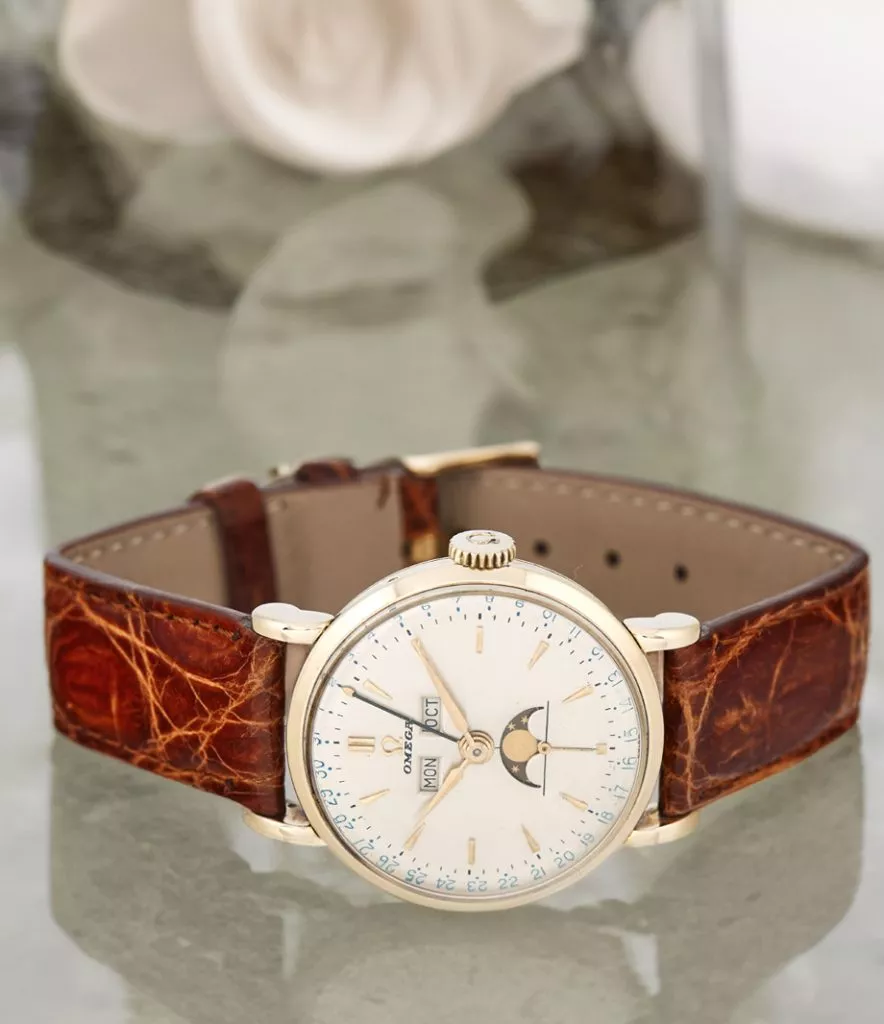
First introduced in 1947, the Cosmic was Omega’s first watch to combine the time and date with a calendar function displaying the date, day of the week, month and phase of the moon.
At the time of its release, a triple calendar complication was representative of the height of prowess in wristwatches. Nearly every noteworthy brand made them, from Patek Philippe to Rolex. While surviving examples produced by Patek Philippe or Rolex may sell for £20,000+, the Omega Cosmic is far more accessible and can be found at a fraction of the price.
A great example from this collection is the Triple Date Moonphase Model Ref.2473.
The elegant dial displays its 4 complications (indicating the day, the date, the month and the phase of the moon) in a simple, uncluttered fashion.
When the light reflects against the silver dial complimenting the applied yellow gold ‘arrowhead’, ‘baton’ hour indices and original ‘lance’ hands. The black sweep date hand features a leaf on the very end which frames the day of the month perfectly. All elements of this stunning display complement each other perfectly.
This particular watch has a Calibre 381 hand-wound, Triple Date Moonphase movement. This movement superseded the earlier Omega Calibre 321 Triple Date, on which this movement is based.
The 4 complications were an amazing feat when it was first produced, yet this movement was completely designed and produced in-house by Omega. These watches are accurate and reliable, and because this movement was produced by Omega, servicing and replacement parts are never a problem.
Omega Constellation Calendar
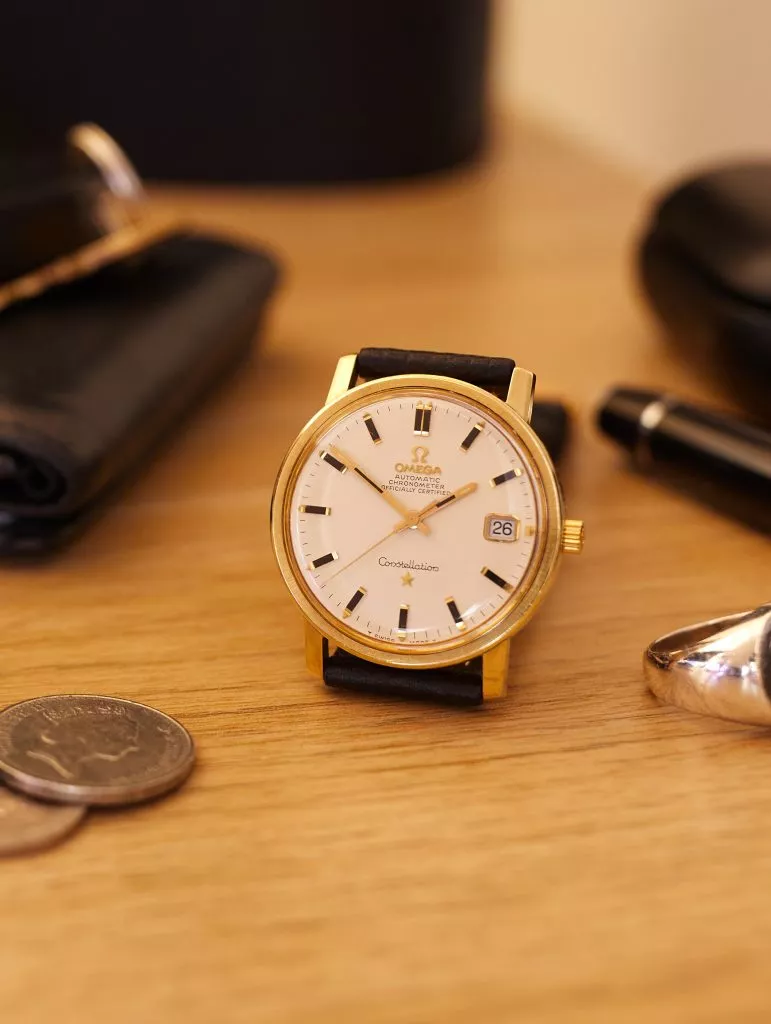
The Constellation was once Omega’s flagship model. Launched in 1952, with its high-quality construction and luxurious design, the Constellation quickly became known as “the Swiss watch.”
The Constellation got its name from the emblem on the case back, which shows an observatory with eight stars above it. The eight stars symbolise two chronometer records and six first-place awards that Omega earned between 1933 and 1952.
One of the most distinctive features of the early Constellation watches was the distinctive faceted convex dial. It’s called a “pie-pan dial” by enthusiasts – as it looks a bit like an upside-down baking dish. The pie-pan dials are some of the most beautiful dial designs in the history of watchmaking, with 12 facets.
Over the years, Omega produced many different Constellation models, with a wide variation in case shape and dial design. A good example of a 1950s original Constellation is this Calendar 18ct Pink Gold Cal.504 from 1957. The solid gold dial is lovely. It adds the perfect amount of texture to complement the bold onyx inlaid block hour indices which are matched with the original ‘dauphine’ style hands, providing the classic smart 1950s functional aesthetic.
This example contains the Omega Calibre 504, the 17 Jewel Automatic Chronometer movement is a true classic. It was the first Omega Constellation calibre to carry the date function. It is quite rare as it was made in fairly small numbers, by far the majority of which are found in the steel, or gold Constellations.
A Calibre 504 found in an 18ct pink gold Constellation is very rare indeed. This watch represents style and elegance, and it’s hard to name a more interesting, or better quality, vintage dress watch.
Omega Seamaster De Ville Automatic
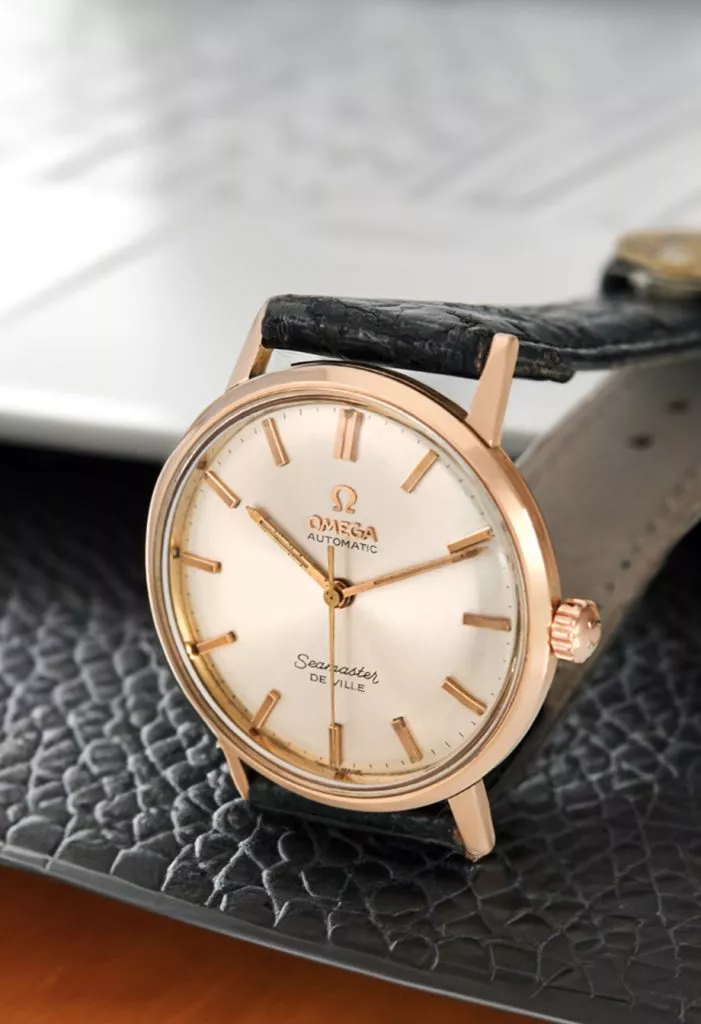
The De Ville was first introduced in 1960 as part of the Seamaster series. In 1963, Omega began printing dials with both ‘Seamaster’ and ‘De Ville’ at the request of Norman Morris, Omega’s United States brand representative.
It wasn’t until 1967 that Omega launched De Ville as a separate line and it quickly became Omega’s best-selling collection, epitomising the elegance and sophistication that Omega is famous for.
From its inception, the Omega De Ville line represented one thing: prestige. Omega combined the water-resistant case of the Seamaster line with high-grade movements more commonly used in other references.
However, the cases of the De Ville line (in any metal) were thinner and more elegant than their sportier contemporaries. Meaning elegance was not substituted for functionality: the De Ville can be worn with a suit and not lose any of its function or style.
A fine example of a 60s De Ville is this 18-carat yellow gold Cal.565. The dial style is classic 1960s Omega, consisting of a silver dial with applied yellow gold ‘baton’ hour indices, matched with original classic ‘index’ hands. This particular example showcases an original dial and hands that are completely unrestored, highlighting its spectacular finish and condition.
It utilises the top grade Calibre 565, 24 Jewel movement which is the same movement used in the top of range Chronometer rated Omega Constellation of the same period. Needless to say, this movement is very highly regarded for its accuracy and reliability, making this model highly esteemed.
The De Ville recalls a time of elegance and svelte modern design that was heralded as being the zenith of fashion in its day. While it is unassuming by today’s excessive standards, it is a benchmark to which many brands, including Omega, are slowly returning.
Vintage Omega’s make up some of the most collectable watches in the vintage market. Likely thanks to the brand’s 175+ year heritage and its dedication to reliability and accuracy in its craft. Marry this with some of the most iconic designs of the 20th century and it’s safe to say that Omega will continue to go from strength to strength as a collector’s favourite.
To keep up to date on vintage watch collecting, sign up for our regular newsletter.


